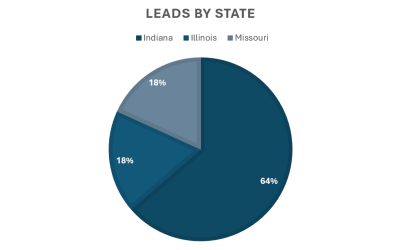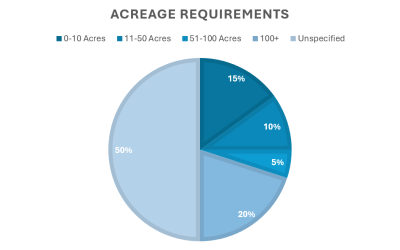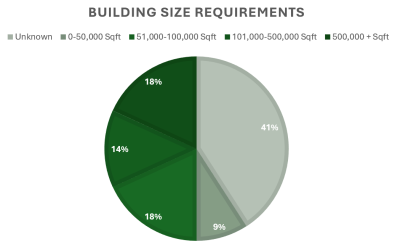The last quarter was active in the regions served by our member co-ops, with a variety of project leads from businesses looking to grow or expand. We can analyze these leads to identify patterns and trends that can support businesses and stakeholders strategizing for long-term success.
You can find below a breakdown of project leads by state, building size, acreage, and industry. Policymakers and economic developers can use this information to develop their strategies to meet evolving needs in different regions and industries. Together, we can leverage this information to plan and foster stronger, more resilient communities adaptable to marketing conditions.

Project Leads by State:
This snapshot of economic activity provides an overview of what interest our member co-ops are receiving for new projects. This can guide resource allocation and strategic planning.
- 13 leads solely interested in Indiana
- 3 leads solely interested in Illinois
- 2 leads solely interested in Missouri
- 1 lead interested in Indiana and Illinois
- 1 lead interested in Missouri and Illinois
- 20 total leads submitted in the 1st quarter

Projects leads by industry:
Industry leads can help economic developers and stakeholders identify emerging trends and sectoral growth patterns. WVPA communities received 11 manufacturing leads in the first quarter. We also submitted leads to warehousing and data center inquires. The popularity of manufacturing n this last quarter reflects what WVPA experienced throughout the past year.

Acreage Requirements
Project leads varied significantly based on the acreage requirements, reflecting diverse types of developments and their spatial needs. In the quarter, the most requested acreage size was 11-50 acres and 100+ acres. We had 11 requests that came in with an unknown acreage need.

The scale of buildings required for projects provides insight into the nature and scope of these developments. In the quarter, the most submitted building size requirement was between 0 to 100,000 square feet. We also received many inquiries with an unknown building size requirement.
The leads from this quarter paint an optimistic picture for continued growth. While there are still challenges to overcome, the momentum we’re seeing in economic development is a testament to the resilience and adaptability of the region. We remain focused on supporting these positive trends and ensuring that our economy is well-positioned to thrive in the years to come.

